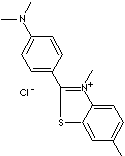THIOFLAVIN T
PRODUCT IDENTIFICATION

CLASSIFICATION
SMILES
c1(c2ccc(N(C)C)cc2)sc2cc(C)ccc2[n+]1C.[ClH-]
EXTRA NOTES
Thioflavin T is a benzothiazole dye that increases in fluorescence upon binding to amyloid. Thioflavin T has been used in histology and for protein characterization
PHYSICAL AND CHEMICAL PROPERTIES
REFRACTIVE INDEX
EXTERNAL LINKS & GENERAL DESCRIPTION
USA.gov - Thioflavine T
Wikipedia Linking - Thioflavin
Google Scholar Search - Thioflavine T
Drug Information Portal (U.S. National Library of Medicine) - Thioflavin T
PubChem Compound Summary - Thioflavine T
http://www.ncbi.nlm.nih.gov/ - Thioflavine T
EPA - Substance Registry Services - Thioflavine T
Local:
The IUPAC Name of free base primuline (mole formula: C21H14N3NaO3S3 mole wt.: 475.53893 g/mol) is 2-[2-(4-Aminophenyl)-1,3-benzothiazol-6-yl]-6-methyl-1,3-benzothiazole-7-sulfonic acid which has the featured methylated and sulfonated benzothiazole ring, derived from dehydrothiotoluidine. Commercially available primuline is usually the homogenous mixture of sodium salts, which should have at least three benzothiazole rings. Primuline (Direct Yellow 59), also called thioflavin S , is a fluorescent dye which used to mark or label other compounds with fluorescent tags. The wave length of the emitted light from fluorescent dye is usually longer than that of the incident light. Thioflavin S is the result from the methylation of dehydrothiotoluidine in the presence of sulfuric acid. Thioflavine T (Basic Yellow 1) is 4-(3,6-dimethyl-1,3-benzothiazol-3-ium-2-yl)-N,N-dimethylaniline which is derived from dehydrothiotoluidine by the methylation with hydrochloric acid. They bind to amyloid fibrils and gives a distinct spectral shift; used to diagnose amyloid fibrils, both ex vivo and in vitro.
APPEARANCE
75.0%
15.0% min
HAZARD OVERVIEW
Not a dangerous substance according to GHS (Globally Harmonised System). Eyes: May cause eye irritation. Skin: May be harmful if absorbed through skin. May cause skin irritation. Inhalation: May be harmful if inhaled. May cause respiratory tract irritation. Ingestion: May be harmful if swallowed.
RISK PHRASES
SAFETY PHRASES